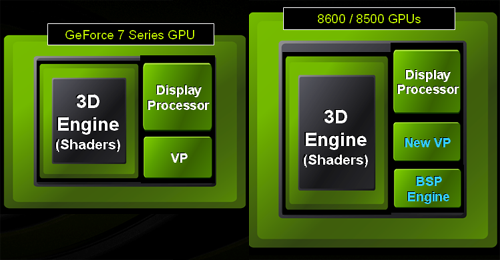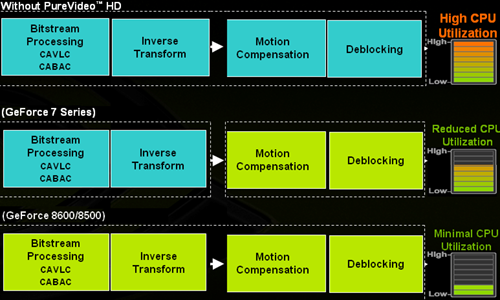DX10 for the Masses: NVIDIA 8600 and 8500 Series Launch
by Derek Wilson on April 17, 2007 9:00 AM EST- Posted in
- GPUs
The New Face of PureVideo HD
The processing requirements of the highest quality HD-DVD and Blu-ray content are non-trivial. Current midrange CPUs struggle to keep up without assistance and older hardware simply cannot perform the task adequately. AMD and NVIDIA have been stepping in with GPU assisted video decode acceleration. With G84, NVIDIA takes this to another level moving well beyond simply accelerating bits and pieces of the process.
The new PureVideo hardware, VP2, is capable of offloading the entire decode process for HD-DVD and Blu-ray movies. With NVIDIA saying that 100% of the H.264 video decode process can be offloaded at up to 40 Mbits/sec on mainstream hardware, the average user will now be able to enjoy HD content on their PC (when prices on HD-DVD and Blu-ray drives fall, of course). There will still be some CPU involvement in the process, as the player will still need to run, AACS does have some overhead, and the CPU is responsible for I/O management.
This is quite a large change, even from the previous version of PureVideo. One of the most processing intensive tasks is decoding the entropy encoded bitstream. Entropy encoding is a method of coding that creates variable length symbols where the size of the symbol is inversely proportional to the probability of encountering it. In other words, patterns that occur often will be represented by short symbols when encoded while less probable patterns will get larger symbols. NVIDIA's BSP (bitstream processor) handles this.

Just adding the decoding of CABAC and CAVLC bitstreams (the two types of entropy encoding supported by H.264) would have helped quite a bit, but G84 also accelerates the inverse transform step. After the bitstream is processed, the data must go through an inverse transform to recover the video stream which then must have motion compensation and deblocking performed on it. This is a bit of an over simplification, but 100% of the process is 100% no matter how we slice it. Here's a look at the breakdown and how CPU involvement has changed between VP1 and VP2.

We have a copy of WinDVD that supports the new hardware acceleration and we are planning a follow up article to investigate real world impact of this change. As we mentioned, in spite of the fact that all video decoding is accelerated on the GPU, other tasks like I/O must be handled by the CPU. We are also interested in finding videos of more than 40 Mbit/sec to try and push the capabilities of the hardware and see what happens. We are interested in discovering the cheapest, slowest processor that can effectively play back full bandwidth HD content when paired with G84 hardware.
It is important to emphasize the fact that HDCP is supported over dual-link DVI, allowing 8600 and 8500 hardware to play HDCP protected content at its full resolution on any monitor capable of displaying 1920x1080. Pairing one of these cards with a Dell 30" monitor might not make sense for gamers, but for those who need maximal 2D desktop space and video playback, the 8600 GT or GTS would be a terrific option.
While it would be nice to have this hardware in NVIDIA's higher end offerings, this technology arguably makes more sense in mainstream parts. High end, expensive graphics cards are usually paired with high end expensive CPUs and lots of RAM. The decode assistance that these higher end cards offer is more than enough to enable a high end CPU to handle the hardest hitting HD videos. With mainstream graphics hardware providing a huge amount of decode assistance, the lower end CPUs that people pair with this hardware will benefit greatly.
The processing requirements of the highest quality HD-DVD and Blu-ray content are non-trivial. Current midrange CPUs struggle to keep up without assistance and older hardware simply cannot perform the task adequately. AMD and NVIDIA have been stepping in with GPU assisted video decode acceleration. With G84, NVIDIA takes this to another level moving well beyond simply accelerating bits and pieces of the process.
The new PureVideo hardware, VP2, is capable of offloading the entire decode process for HD-DVD and Blu-ray movies. With NVIDIA saying that 100% of the H.264 video decode process can be offloaded at up to 40 Mbits/sec on mainstream hardware, the average user will now be able to enjoy HD content on their PC (when prices on HD-DVD and Blu-ray drives fall, of course). There will still be some CPU involvement in the process, as the player will still need to run, AACS does have some overhead, and the CPU is responsible for I/O management.
This is quite a large change, even from the previous version of PureVideo. One of the most processing intensive tasks is decoding the entropy encoded bitstream. Entropy encoding is a method of coding that creates variable length symbols where the size of the symbol is inversely proportional to the probability of encountering it. In other words, patterns that occur often will be represented by short symbols when encoded while less probable patterns will get larger symbols. NVIDIA's BSP (bitstream processor) handles this.

Just adding the decoding of CABAC and CAVLC bitstreams (the two types of entropy encoding supported by H.264) would have helped quite a bit, but G84 also accelerates the inverse transform step. After the bitstream is processed, the data must go through an inverse transform to recover the video stream which then must have motion compensation and deblocking performed on it. This is a bit of an over simplification, but 100% of the process is 100% no matter how we slice it. Here's a look at the breakdown and how CPU involvement has changed between VP1 and VP2.

We have a copy of WinDVD that supports the new hardware acceleration and we are planning a follow up article to investigate real world impact of this change. As we mentioned, in spite of the fact that all video decoding is accelerated on the GPU, other tasks like I/O must be handled by the CPU. We are also interested in finding videos of more than 40 Mbit/sec to try and push the capabilities of the hardware and see what happens. We are interested in discovering the cheapest, slowest processor that can effectively play back full bandwidth HD content when paired with G84 hardware.
It is important to emphasize the fact that HDCP is supported over dual-link DVI, allowing 8600 and 8500 hardware to play HDCP protected content at its full resolution on any monitor capable of displaying 1920x1080. Pairing one of these cards with a Dell 30" monitor might not make sense for gamers, but for those who need maximal 2D desktop space and video playback, the 8600 GT or GTS would be a terrific option.
While it would be nice to have this hardware in NVIDIA's higher end offerings, this technology arguably makes more sense in mainstream parts. High end, expensive graphics cards are usually paired with high end expensive CPUs and lots of RAM. The decode assistance that these higher end cards offer is more than enough to enable a high end CPU to handle the hardest hitting HD videos. With mainstream graphics hardware providing a huge amount of decode assistance, the lower end CPUs that people pair with this hardware will benefit greatly.










60 Comments
View All Comments
kilkennycat - Tuesday, April 17, 2007 - link
(As of 8AM Pacific Time, April 17)See:-
http://www.zipzoomfly.com/jsp/ProductDetail.jsp?Pr...">http://www.zipzoomfly.com/jsp/ProductDetail.jsp?Pr...
http://www.zipzoomfly.com/jsp/ProductDetail.jsp?Pr...">http://www.zipzoomfly.com/jsp/ProductDetail.jsp?Pr...
Chadder007 - Tuesday, April 17, 2007 - link
Thats really not too bad for a DX10 part. I just wish we actually had some DX10 games to see how it performs though....bob4432 - Tuesday, April 17, 2007 - link
that performance is horrible. everyone here is pretty dead on - this is strictly for marketing to the non-educated gamer. too bad they will be disappointed and probably return such a piece of sh!t item. what a joke.come on ati, this kind of performance should be in the low end cards, this is not a mid-range card. maybe if nvidia sold them for $100-$140 they may end up in somebody htpc but that is about all they are good for.
glad i have a 360 to ride out this phase of cards while my x1800xt still works fine for my duties.
if i were the upper management at nvidia, people would be fired over this horrible performance, but sadly the upper management is more than likely the cause of this joke of a release.
AdamK47 - Tuesday, April 17, 2007 - link
nVidia needs to have people with actual product knowledge dictate what the specifications of future products will be. This disappointing lineup has marketing written all over it. They need to wise up or they will end up like Intel and their failed marketing derived netburst architecture.wingless - Tuesday, April 17, 2007 - link
In the article they talk about the Pure Video features as if they are brand new. Does this mean they ARE NOT implemented in the 8800 series? The article talked about how 100% of the video decoding process is on the GPU but it did not mention the 8800 core which worries the heck outta me. Also does the G84 have CUDA capabilities?DerekWilson - Tuesday, April 17, 2007 - link
CUDA is supportedDerekWilson - Tuesday, April 17, 2007 - link
The 8800 series support PureVideo HD the same way GeForce 7 sereis does -- through VP1 hardware.The 8600 and below support PureVideo HD through VP2 hardware, the BSP, and other enhancements which allow 100% offload of decode.
While the 8800 is able to offload much of the process, it's not 100% like the 8600/8500. Both support PureVideo HD, but G84 does it with lower CPU usage.
wingless - Tuesday, April 17, 2007 - link
I just checked NVIDIA's website and it appears only the 8600 and 8500 series support Pure Video HD which sucks balls. I want 8800GTS performance with Pure Video HD support. Guess I'll have to wait a few more months, or go ATI but ATI's future isn't stable these days.defter - Tuesday, April 17, 2007 - link
Why you want 8800GTS performance with improved Purevideo HD support? Are you going to pair 8800GTS with $40 Celeron? 8800GTS has more than enough power to decode H.264 at HD resolutions as long as you pair with modern CPU: http://www.anandtech.com/printarticle.aspx?i=2886">http://www.anandtech.com/printarticle.aspx?i=2886This improved Purevide HD is aimed for low-end systems that are using a low end-CPU. That's why this feature is important for low/mid-range GPUs.
wingless - Tuesday, April 17, 2007 - link
If I'm going to spend this kind of money for an 8800 series card then I want VP2 100% hardware decoding? Is that too much to ask? I want all the extra bells and whistles. Damn, I may have to go ATI for the first time since 1987 when I had that EGA Wonder.